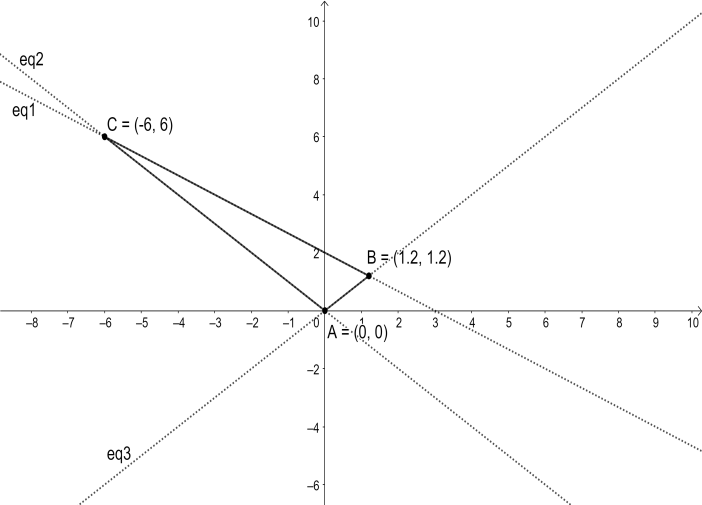
The combined equation of three sides of a triangle is $\left( {{x}^{2}}-{{y}^{2}} \right)\left( 2x+3y-6 \right)=0$. If $\left( \sec \theta ,1 \right)$ is an interior point of the triangle then find the value of $\theta $.
Answer
569.1k+ views
Hint: We will factorize the given equation to find the three sides of the triangle. Then we will look at the range of the x-coordinate for the interior points of the triangle. The value of $\sec \theta $ will have to lie inside this range. We will use the inverse trigonometric function ${{\sec }^{-1}}\theta $ to find the value of $\theta $.
Complete step by step answer:
The given equation is $\left( {{x}^{2}}-{{y}^{2}} \right)\left( 2x+3y-6 \right)=0$. We can further factorize this equation using the identity $\left( {{a}^{2}}-{{b}^{2}} \right)=\left( a+b \right)\left( a-b \right)$ in the following manner,
$\left( x+y \right)\left( x-y \right)\left( 2x+3y-6 \right)=0$.
This implies that we have the following three equations,
$x+y=0$....(i)
$x-y=0$....(ii)
$2x+3y-6=0$....(iii)
We can see that the point of intersection of equation (i) and equation (ii) is $\left( 0,0 \right)$.
We will substitute $x=-y$ from equation (i) in equation (iii), as follows,
$2\left( -y \right)+3y-6=0$
Solving the above equation for $y$, we get
$\begin{align}
& y-6=0 \\
& \therefore y=6 \\
\end{align}$
Therefore, we get $x=-6$. Hence, the point of intersection of equation (i) and equation (iii) is $\left( -6,6 \right)$.
Similarly, we will substitute $x=y$ from equation (ii) in equation (iii), as follows,
$2y+3y-6=0$
Solving the above equation for $y$, we get
$\begin{align}
& 5y-6=0 \\
& \therefore y=\dfrac{6}{5}=1.2 \\
\end{align}$
Therefore, we get $x=\dfrac{6}{5}=1.2$. Hence, the point of intersection of equation (ii) and equation (iii) is $\left( \dfrac{6}{5},\dfrac{6}{5} \right)=\left( 1.2,1.2 \right)$.
Now, we know that the range of the secant function is $\left( -\infty ,-1 \right]\cup \left[ 1,\infty \right)$. The intersection of the range of the secant function and the triangle is $\left[ -6,-1 \right]\cup \left[ 1,1.2 \right]$. Therefore, $\sec \theta \in \left[ -6,-1 \right]\cup \left[ 1,1.2 \right]$. Hence, $\theta \in \left[ {{\sec }^{-1}}\left( -6 \right),{{\sec }^{-1}}\left( -1 \right) \right]\cup \left[ {{\sec }^{-1}}\left( 1 \right),{{\sec }^{-1}}\left( 1.2 \right) \right]$, that is $\theta \in \left[ {{\sec }^{-1}}\left( -6 \right),\pi \right]\cup \left[ 0,{{\sec }^{-1}}\left( 1.2 \right) \right]$.
Note: We can plot the graph of the three equations and look at the triangle formed as shown in the figure below,

The specific values for arcsec functions are a bit difficult to calculate. We should be familiar with the principle values for inverse trigonometric functions.
Complete step by step answer:
The given equation is $\left( {{x}^{2}}-{{y}^{2}} \right)\left( 2x+3y-6 \right)=0$. We can further factorize this equation using the identity $\left( {{a}^{2}}-{{b}^{2}} \right)=\left( a+b \right)\left( a-b \right)$ in the following manner,
$\left( x+y \right)\left( x-y \right)\left( 2x+3y-6 \right)=0$.
This implies that we have the following three equations,
$x+y=0$....(i)
$x-y=0$....(ii)
$2x+3y-6=0$....(iii)
We can see that the point of intersection of equation (i) and equation (ii) is $\left( 0,0 \right)$.
We will substitute $x=-y$ from equation (i) in equation (iii), as follows,
$2\left( -y \right)+3y-6=0$
Solving the above equation for $y$, we get
$\begin{align}
& y-6=0 \\
& \therefore y=6 \\
\end{align}$
Therefore, we get $x=-6$. Hence, the point of intersection of equation (i) and equation (iii) is $\left( -6,6 \right)$.
Similarly, we will substitute $x=y$ from equation (ii) in equation (iii), as follows,
$2y+3y-6=0$
Solving the above equation for $y$, we get
$\begin{align}
& 5y-6=0 \\
& \therefore y=\dfrac{6}{5}=1.2 \\
\end{align}$
Therefore, we get $x=\dfrac{6}{5}=1.2$. Hence, the point of intersection of equation (ii) and equation (iii) is $\left( \dfrac{6}{5},\dfrac{6}{5} \right)=\left( 1.2,1.2 \right)$.
Now, we know that the range of the secant function is $\left( -\infty ,-1 \right]\cup \left[ 1,\infty \right)$. The intersection of the range of the secant function and the triangle is $\left[ -6,-1 \right]\cup \left[ 1,1.2 \right]$. Therefore, $\sec \theta \in \left[ -6,-1 \right]\cup \left[ 1,1.2 \right]$. Hence, $\theta \in \left[ {{\sec }^{-1}}\left( -6 \right),{{\sec }^{-1}}\left( -1 \right) \right]\cup \left[ {{\sec }^{-1}}\left( 1 \right),{{\sec }^{-1}}\left( 1.2 \right) \right]$, that is $\theta \in \left[ {{\sec }^{-1}}\left( -6 \right),\pi \right]\cup \left[ 0,{{\sec }^{-1}}\left( 1.2 \right) \right]$.
Note: We can plot the graph of the three equations and look at the triangle formed as shown in the figure below,

The specific values for arcsec functions are a bit difficult to calculate. We should be familiar with the principle values for inverse trigonometric functions.
Recently Updated Pages
Why are manures considered better than fertilizers class 11 biology CBSE

Find the coordinates of the midpoint of the line segment class 11 maths CBSE

Distinguish between static friction limiting friction class 11 physics CBSE

The Chairman of the constituent Assembly was A Jawaharlal class 11 social science CBSE

The first National Commission on Labour NCL submitted class 11 social science CBSE

Number of all subshell of n + l 7 is A 4 B 5 C 6 D class 11 chemistry CBSE

Trending doubts
What is meant by exothermic and endothermic reactions class 11 chemistry CBSE

10 examples of friction in our daily life

One Metric ton is equal to kg A 10000 B 1000 C 100 class 11 physics CBSE

1 Quintal is equal to a 110 kg b 10 kg c 100kg d 1000 class 11 physics CBSE

Difference Between Prokaryotic Cells and Eukaryotic Cells

What are Quantum numbers Explain the quantum number class 11 chemistry CBSE




